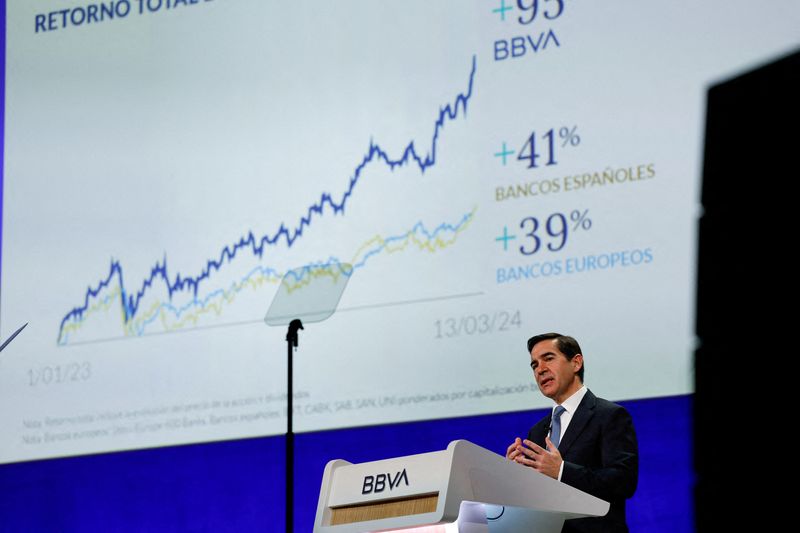
©Reuters. BBVA President Carlos Torres Vila addresses the annual general meeting of shareholders at the Palacio Euskalduna in Bilbao, Spain, March 15, 2024. REUTERS/Vincent West/File Photo
2/2
By Jesús Aguado
MADRID (Reuters) – The share price of BBVA (BME:) has more than tripled since the end of 2020, narrowing the valuation gap with Santander (BME:) and highlighting a divergence in fortunes among Spanish banks that could be short term.
Both trace their roots to 1857 and nearby cities in northern Spain, but Santander has emerged as the dominant bank in Spain with more than double BBVA’s assets and, until very recently, a much larger market capitalization.
But the gap has narrowed from 20 billion euros ($22 billion) three years ago to around 5.5 billion euros, raising questions about which has adopted the right strategy.
This shift reflects how investors are rewarding banks that share a larger share of their recovering profits over those that prioritize investing in future growth, as well as those that have made the right bets outside of Europe slower growing.
BBVA shares, worth around 64 billion euros compared to Santander’s market value of 69.5 billion euros, were supported by its Mexican subsidiary, which holds around a quarter of the retail market.
“BBVA has in Mexico one of the best retail banking franchises in any emerging market and it is doing even better for BBVA than in Brazil for Santander,” said Enrique Quemada, president of investment bank ONEtoONE Corporate Finance Group.
Investors also rewarded BBVA for deciding to leave the United States in November 2020 to focus on distributing more cash to shareholders, analysts and investors told Reuters.
“With regards to growth, profitability … increasing dividends and share buybacks, the market continues to reward us,” BBVA President Carlos Torres told shareholders this month.
Torres has been president since late 2018, when Onur Genç became CEO of BBVA.
Since 2021, BBVA has distributed €13.19 billion to shareholders, including extraordinary buybacks of €4.16 billion. That equates to 20.6% of its current market valuation, Reuters calculations show.
A more cautious approach to distributions under Santander chairwoman Ana Botin, declining profitability in Brazil and mixed fortunes in some of its top 10 markets have hampered the largest bank’s shares, analysts and investors added.
Botin, whose father Emilio previously ran Santander, has held the role since his death in September 2014.
Santander, which unlike BBVA does not carry out extraordinary buybacks, paid 12.8 billion euros, equal to 18.4% of its market capitalisation, according to Reuters calculations.
The focus on capital distribution has driven shares of other European banks such as Italy’s UniCredit higher, while stocks with less generous payout policies, including Santander and BNP Paribas (OTC:), have lagged.
Santander Chief Financial Officer Jose Garcia Cantera told Reuters that investors’ preference for payments today in a period of high interest rates rather than heavily discounted future profits will not last as rates fall.
“Future growth will be more appreciated… We are starting to see the first signs of that,” Cantera said.
BBVA declined to comment.
MORE DIVERSIFIED
While BBVA can’t compete with Santander in terms of scope and scale, its shares trade at more than 1.2 times book value thanks to a 32.5% jump so far in 2024.
Santander shares have risen 15.5% in the same period, but trade at just over 0.7 times book value, in the bottom third of Europe’s big banks, LSEG data shows.
“For Santander there are so many moving parts… you need a lot of stars to align,” said London-based Berenberg analyst Michael Christodoulou, who expects it will benefit from falling rates that ease concerns about the quality of assets, also in Brazil.
Christodoulou recommended a suspension on both banks.
Whether BBVA shares maintain their momentum will depend as much on capital returns as on its ability to meet its financial targets in key Mexican and Spanish markets, given its greater exposure to fewer countries than Santander.
BBVA makes more than two-thirds of its profits in emerging markets and is reinvesting in fewer businesses than Santander.
BBVA expects a return on tangible capital (ROTE), a measure of profitability, of 17% to 20% in 2024 from 17% in 2023, while Santander is targeting a ROTE of 16% in 2024, up from 15.06 % of last year.
Analysts at broker Alantra expect Santander to benefit in the medium to long term from cost savings as it launches global units and deliver faster profit growth.
Improved performance of Santander’s auto lending business in Europe and the United States is also expected to help.
Yet Santander needs to improve profitability in Brazil, other analysts say, adding that its expansion plans in the United States must pay off following a 48% drop in net profit in 2023.
To keep BBVA at bay, Santander would have to become more aggressive on buybacks, Caixabank analyst Carlos Peixoto said, adding: “but at this stage they are not in a position to do so.”
Santander’s core Tier 1 Fully Loaded capital ratio, the most rigorous measure of solvency, stood at 12.26% at the end of last year, compared to BBVA’s 12.67%.
Santander said on March 22 that it expects to pay more than 6 billion euros in dividends and ordinary share buybacks against its 2024 results under its policy of distributing half of its profits to shareholders.
Santander’s strategy to invest in a more diversified range of businesses will be rewarded over time, Cantera said.
“When things change and the market starts to value growth more, those banks that have not invested for the future will find themselves at a disadvantage,” he added.
($1 = 0.9245 euros)